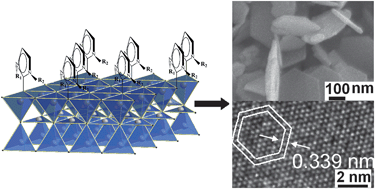Cu2−xSe
nanocrystals and CuSe nanoflakes are successfully synthesized through a convenient hydrothermal method from an ionic liquid precursor 1-n-butyl-3-ethylimidazolium methylselenite ([BMIm][SeO2(OCH3)]). The phases and morphologies of the copper selenides can be controlled by simply changing the atom ratio of Cu/Se in the reactants and reaction temperature. Furthermore, it is found that the [BMIm][SeO2(OCH3)] not only serves as Se source but also has influence on the shapes of CuSe nanoflakes. The adsorption of alkyl imidazolium rings ([BMIm]+) onto the (0001) facets of covellite CuSe prohibits the growth in the [0001] direction, and CuSe nuclei growth mainly processes along the six symmetric directions (±[0![[1 with combining macron]](https://www.rsc.org/images/entities/char_0031_0304.gif) 11], ±[10
11], ±[10![[1 with combining macron]](https://www.rsc.org/images/entities/char_0031_0304.gif)
![[1 with combining macron]](https://www.rsc.org/images/entities/char_0031_0304.gif) ], and ±[
], and ±[![[1 with combining macron]](https://www.rsc.org/images/entities/char_0031_0304.gif) 100]) to form flakelike CuSe. The obtained copper selenides are characterized by XRD, SEM, EDS, XPS, TEM, and HRTEM. The results indicate that the Cu2−xSe nanocrystals are nearly spherical particles with an average diameter of about 20 nm, the hexagonal CuSe nanoflakes are single crystals with an edge length of 100–400 nm and a thickness of 25–50 nm. The potential formation mechanism of the copper selenides is also proposed.
100]) to form flakelike CuSe. The obtained copper selenides are characterized by XRD, SEM, EDS, XPS, TEM, and HRTEM. The results indicate that the Cu2−xSe nanocrystals are nearly spherical particles with an average diameter of about 20 nm, the hexagonal CuSe nanoflakes are single crystals with an edge length of 100–400 nm and a thickness of 25–50 nm. The potential formation mechanism of the copper selenides is also proposed.

You have access to this article
 Please wait while we load your content...
Something went wrong. Try again?
Please wait while we load your content...
Something went wrong. Try again?
![[1 with combining macron]](https://www.rsc.org/images/entities/char_0031_0304.gif) 11], ±[10
11], ±[10![[1 with combining macron]](https://www.rsc.org/images/entities/char_0031_0304.gif)
![[1 with combining macron]](https://www.rsc.org/images/entities/char_0031_0304.gif) ], and ±[
], and ±[![[1 with combining macron]](https://www.rsc.org/images/entities/char_0031_0304.gif) 100]) to form flakelike CuSe. The obtained copper selenides are characterized by
100]) to form flakelike CuSe. The obtained copper selenides are characterized by 

 Please wait while we load your content...
Please wait while we load your content...